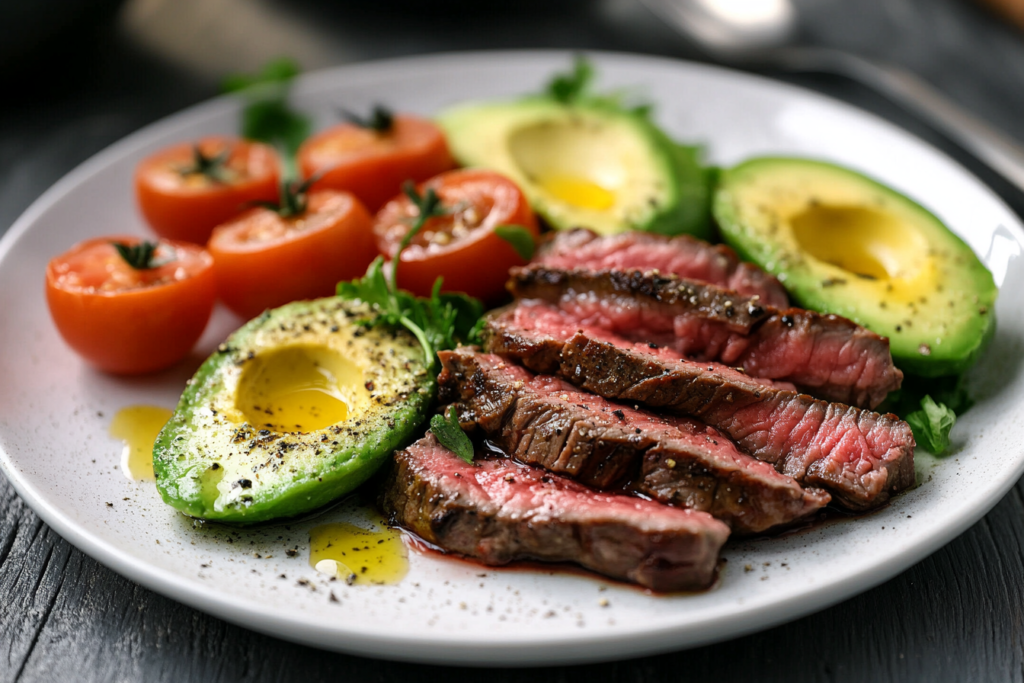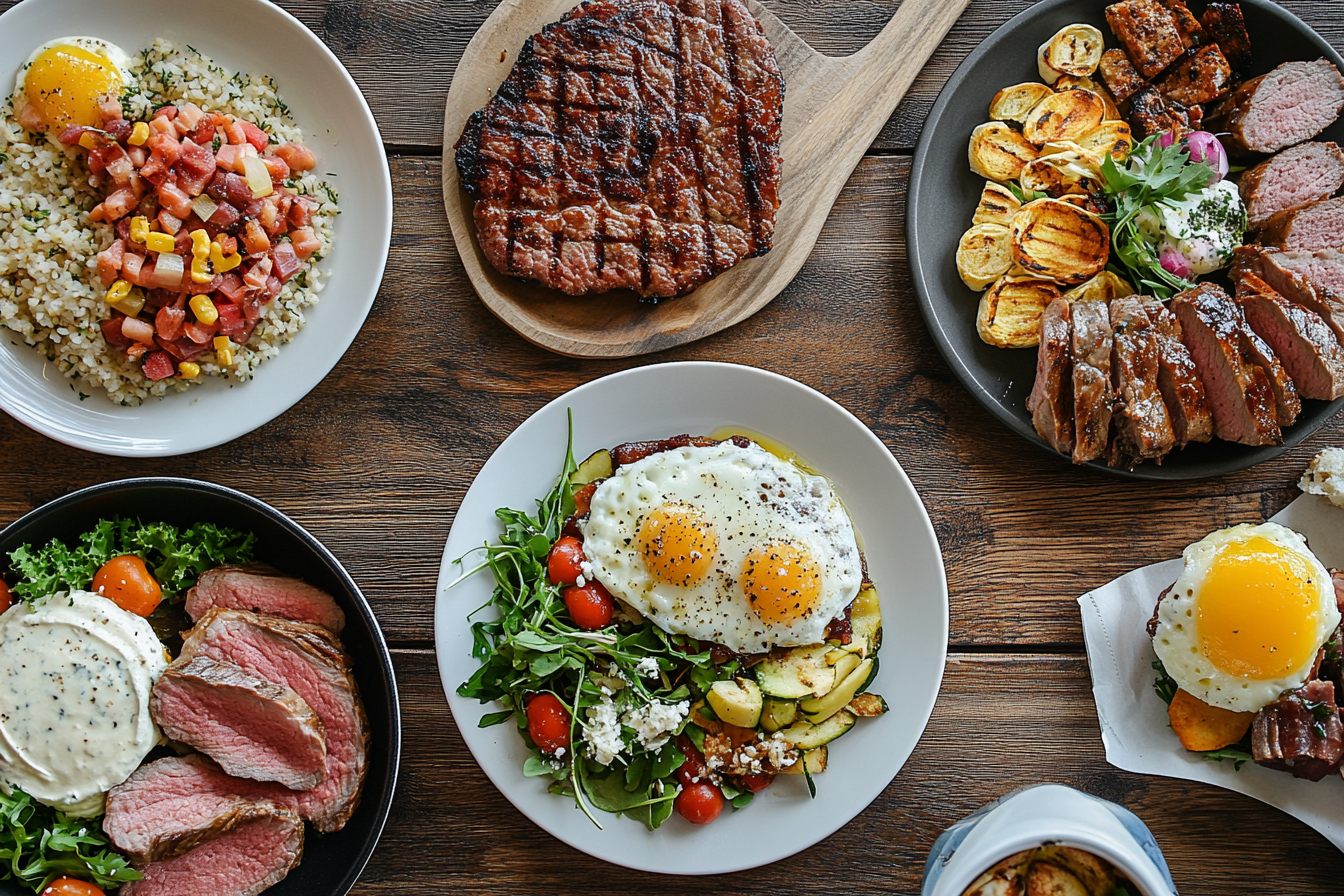Table of Contents
Introduction
Breakfast is often considered the most important meal of the day, setting the tone for energy levels, focus, and nutrition. Incorporating meat into your morning meals can be a game-changer, providing a protein-packed start that sustains you through busy mornings. Meat-based breakfasts aren’t just about indulgence; they can also be healthy, versatile, and downright delicious.
Benefits of Meat in Breakfast

Meat has long been a staple in breakfast dishes worldwide. Whether a slice of lean ham, turkey sausage, or a hearty steak, incorporating meat into your morning meal can provide numerous health benefits. Let’s dive into why meat is an excellent choice for breakfast and how it contributes to a balanced diet.
Nutritional Advantages of Meat at Breakfast
Meat is a nutrient-dense food that offers many essential vitamins and minerals. When included in breakfast, it provides several key advantages:
- High-Quality Protein: Meat is a complete protein source, meaning it contains all nine essential amino acids that the body cannot produce independently. Starting your day with protein helps in muscle repair and maintenance.
- Rich in Micronutrients: Meat, especially lean cuts, is an excellent source of iron, zinc, B vitamins (like B12), and selenium, all of which support energy production and immune health.
- Low-Carb Energy Source: Unlike carbohydrate-heavy breakfasts, meat can provide a low-carb alternative that doesn’t spike blood sugar levels, making it a great option for sustained energy.
Protein Power and Satiety
Including meat in breakfast has been shown to improve satiety, helping you feel fuller for longer. Protein takes longer to digest than carbs, reducing mid-morning hunger and curbing overeating later in the day.
- Weight Management: High-protein meals are linked to reduced daily calorie intake.
- Energy Balance: A protein-rich breakfast stabilizes blood sugar levels, minimizing energy crashes.
Popular Meat Choices for Breakfast
When choosing meat for breakfast, prioritize lean cuts lower in saturated fats and calories. Here are some common and healthy options:
- Turkey: A lean and versatile option, turkey sausage or slices offer high protein with fewer calories and fat.
- Chicken: Grilled or shredded chicken pairs well with eggs and vegetables.
- Lean Beef: Ground beef or steak (trimmed of fat) is rich in iron and ideal for hearty breakfast recipes.
- Pork: Opt for lean cuts of ham or Canadian bacon to keep it healthy.
- Fish: Smoked salmon or canned tuna can be a delicious addition to morning meals.
Balancing Meat with Other Nutrients
To ensure your breakfast is not just protein-heavy but also balanced:
- Add Vegetables: Enhance the fiber and vitamin content by pairing meat with sautéed spinach, tomatoes, or bell peppers.
- Include Healthy Fats: Avocado, nuts, or olive oil can complement meat while adding heart-healthy fats.
- Incorporate Whole Grains: Whole-grain bread, oats, or quinoa provide necessary carbs for sustained energy.
Including meat in your breakfast offers a practical, nutritious, and satisfying way to start the day. Next, let’s look at some delicious recipes that bring these benefits to life.
Breakfast Steak with Avocado and Tomatoes
Ingredients:
- 1 lean steak (sirloin or flank, 4-6 oz)
- 1/2 avocado, sliced
- 1 cup of cherry tomatoes, halved
- 1 teaspoon of olive oil
- Salt, pepper, and garlic powder to taste
Instructions:
- Season the steak with salt, pepper, and garlic powder.
- Heat olive oil in a skillet over medium-high heat. Cook the steak to your desired doneness (3-4 minutes per side for medium rare).
- Plate the steak alongside sliced avocado and cherry tomatoes.
- Drizzle with olive oil and serve immediately.
Why It’s Healthy:
This dish combines a high-protein steak with heart-healthy fats from avocado and antioxidant-rich tomatoes.
Chicken Breakfast Burrito Bowl
Ingredients:
- 1 cup of shredded chicken breast
- 1/2 cup of cooked quinoa or brown rice
- 1/2 cup of black beans
- 1/4 cup of salsa
- 1/4 avocado, diced
- Fresh cilantro for garnish
Instructions:
- In a bowl, layer quinoa or rice as the base.
- Add shredded chicken, black beans, and salsa on top.
- Garnish with diced avocado and cilantro. Serve warm.
Why It’s Healthy:
This burrito bowl offers a protein-packed, fiber-filled, nutrient-dense, gluten-free breakfast.
Ground Beef and Sweet Potato Hash
Ingredients:
- 1/2 pound of lean ground beef
- 1 medium sweet potato, peeled and diced
- 1/2 onion, chopped
- 1 teaspoon of paprika
- Salt and pepper to taste
Instructions:
- In a skillet over medium heat, cook the ground beef until browned, then drain any excess fat.
- Add the sweet potato, onion, and paprika. Cover and cook until the sweet potato is tender, stirring occasionally.
- Season with salt and pepper. Serve hot.
Why It’s Healthy:
This hash is rich in iron, protein, and complex carbs, making it a filling and energizing breakfast.
Tips for Preparing Healthy Meat Breakfasts
Cooking healthy meat breakfasts requires thoughtful preparation to ensure they are delicious and nutritious. You can elevate your breakfast routine by selecting quality ingredients, using the right cooking techniques, and incorporating balanced accompaniments.
Choosing the Right Meats
Not all meat is created equal. Choosing lean cuts and minimally processed options can significantly improve the healthiness of your meal.
- Go for Lean Cuts: Opt for meats like chicken breast, turkey, pork loin, and lean beef.
- Check the Labels: Avoid processed meats high in sodium or artificial additives, such as certain sausages or cured products. Look for “low-sodium” or “natural” labels.
- Explore Alternatives: Consider healthier options like turkey bacon instead of traditional pork bacon.
Cooking Techniques to Retain Nutrients
How you cook your meat affects its nutritional value and overall health.
- Grilling: A great option for reducing fat content, as excess fat drips away during cooking.
- Sautéing: Use a light spray of olive oil or avocado oil to keep it low in calories.
- Baking or Roasting: Ideal for cooking and preserving the meat’s nutrients.
- Avoid Deep-Frying: It adds unnecessary calories and unhealthy fats.
Incorporating Vegetables and Herbs
Pairing meat with vegetables adds fiber, vitamins, and minerals to your breakfast.
- Sautéed Greens: Spinach, kale, or Swiss chard complement meats beautifully.
- Colorful Veggies: Peppers, zucchini, and tomatoes provide nutrition and visual appeal.
- Fresh Herbs: Cilantro, parsley, or basil add flavor without the need for excessive salt.
Balancing Protein with Other Nutrients
A healthy breakfast isn’t just about meat. Balancing your meal with other food groups ensures optimal nutrition.
- Whole Grains: Serve meat alongside whole-grain bread, quinoa, or brown rice for added fiber and energy.
- Healthy Fats: Incorporate avocados, nuts, or seeds for their heart-health benefits.
- Low-Fat Dairy: Pair with Greek yogurt or low-fat cheese for additional protein and calcium.
Meal Prepping for Efficiency
Preparing breakfast in advance saves time and ensures you stick to your health goals.
- Batch Cooking: Cook large quantities of meat (e.g., grilled chicken or turkey sausage) and refrigerate or freeze portions.
- Ready-to-Use Ingredients: Chop vegetables and portion them for quick use in recipes.
- Storage Tips: Store cooked meats in airtight containers to maintain freshness for up to 3-4 days.
Best Pairings for Meat Breakfasts

A well-rounded breakfast doesn’t stop with meat—it thrives on variety. Pairing meat with the right sides and beverages enhances flavor and boosts your meal’s nutritional value. Let’s explore some excellent pairings to complete your breakfast.
Healthy Sides to Complement Meat
1. Fruits:
Fresh fruits add natural sweetness and provide essential vitamins, antioxidants, and fiber.
- Best Choices: Berries (blueberries, strawberries), citrus fruits (orange slices, grapefruit), or diced melons.
- Why It Works: The lightness of fruit balances the richness of meat dishes.
2. Whole Grains:
Whole grains contain complex carbohydrates that provide sustained energy throughout the day.
- Best Choices: Whole-grain toast, oatmeal, or quinoa.
- Why It Works: The fiber in whole grains helps maintain fullness and aids digestion.
3. Vegetables:
Vegetables aren’t just for lunch or dinner they’re a great addition to breakfast.
- Best Choices: Roasted sweet potatoes, sautéed spinach, or a mixed greens salad.
- Why It Works: Vegetables contain extra vitamins and minerals while keeping calories low.
Dairy Options for a Balanced Breakfast
Incorporating dairy into your breakfast can increase calcium and protein content.
- Low-Fat Yogurt: A creamy and refreshing addition to meat dishes, especially in breakfast bowls or as a dip.
- Cheese: Low-fat varieties like feta, mozzarella, or cottage cheese can enhance the flavor of egg-based meat dishes.
- Milk Alternatives: Unsweetened almond or oat milk pairs well in breakfast beverages or smoothies.
Beverages to Complete Your Meal
Hydration and the right beverage choice can elevate your breakfast experience.
- Water: Start your day with a glass of water to rehydrate after sleep.
- Coffee or Tea: Black coffee, green tea, or herbal teas complement savory meat dishes while offering antioxidants.
- Smoothies: Blend fruits, greens, and yogurt for a nutrient-packed drink to enjoy alongside your meal.
Examples of Balanced Breakfast Pairings
- Turkey Sausage and Veggie Scramble with whole-grain toast and orange slices.
- Lean Ham and Egg Muffins paired with roasted sweet potatoes and a cup of green tea.
- Breakfast steak with avocado and tomatoes served with a mixed green salad and black coffee.
- Ground Beef and Sweet Potato Hash with a dollop of Greek yogurt and a berry smoothie.
FAQs
Can I Prepare Meat Breakfasts in Advance?
Absolutely! Meal-prepping meat breakfasts is a practical way to save time and ensure you have nutritious options.
- How to Prep: Cook meats like turkey sausage, lean ham, or grilled chicken in large batches and store them in airtight containers.
- Storage Tips: Refrigerate for 3-4 days or freeze for longer storage. Reheat in a microwave or skillet before serving.
- Examples: Egg muffins, burrito bowls, or sweet potato hash are excellent meal prep options.
What Are the Healthiest Meats to Include in Breakfast?
The healthiest meats are lean, minimally processed, and rich in protein.
- Top Choices: Turkey, chicken, lean beef, pork loin, and fish like smoked salmon.
- Why Lean is Better: They are lower in saturated fat and calories while still providing essential nutrients.
Are There Vegetarian Substitutes for Meat?
Yes, many plant-based substitutes mimic the texture and flavor of meat.
- Options to Try: Tofu, tempeh, seitan, or plant-based sausage.
- Recipe Adaptations: You can replace ground beef in hash with crumbled tofu or use veggie sausage in place of turkey sausage.
How Do I Ensure My Meat is Cooked Safely?
Proper cooking ensures that your meat is safe to eat and retains its nutritional value.
- Temperature Guide: Use a meat thermometer to check internal temperatures 165°F for poultry, 160°F for ground beef, and 145°F for pork or steak.
- Avoid Cross-Contamination: Use separate cutting boards and utensils for raw meat and wash hands thoroughly.
Conclusion
Starting the day with a protein-rich breakfast can keep you full and energized. If you want more ideas, these Chicken Breakfast Recipes offer a lean and flavorful way to start the morning. For those who enjoy a heartier dish, the Ground Beef Breakfast Recipes provide a satisfying and nutritious option. If you want a convenient and protein-packed meal, try these Make-Ahead Breakfast Burritos that are perfect for busy mornings. Looking to pair your meal with something crispy? These Sausage Hash Brown Casserole or Sausage Cream Cheese Crescent Rolls make great side options. And if you prefer a pescatarian twist, you can explore these Salmon Breakfast Recipes for a dose of omega-3s and your morning meal.

